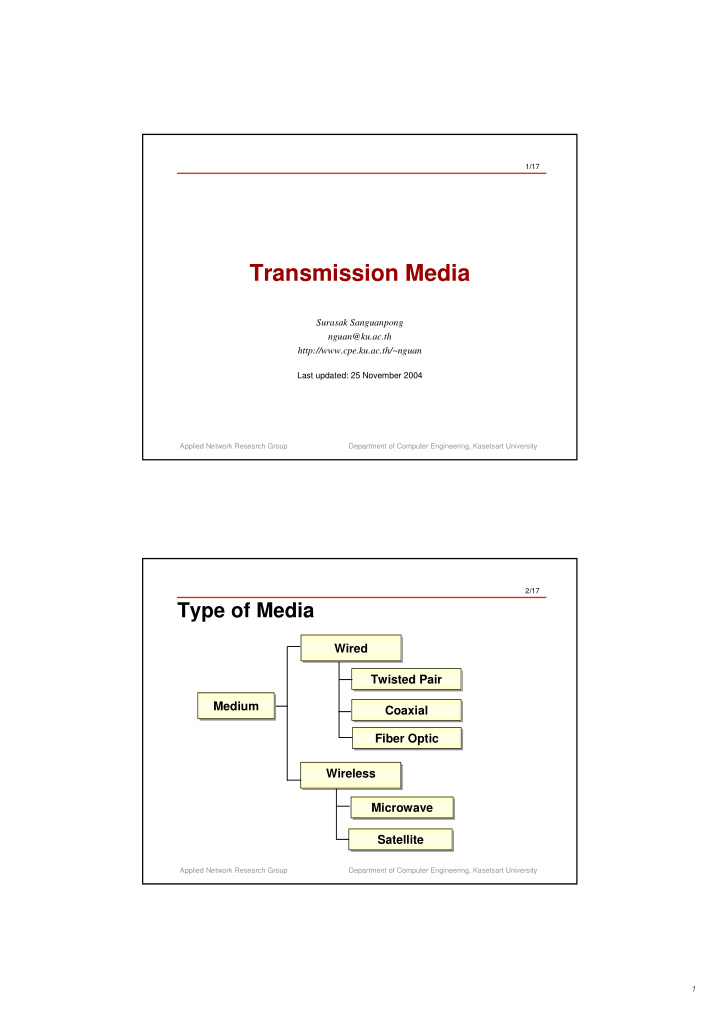



1 / 17 Transmission Media Surasak Sanguanpong nguan@ku.ac.th http://www.cpe.ku.ac.th/~nguan Last updated: 25 November 2004 Applied Network Research Group Department of Computer Engineering, Kasetsart University 2 / 17 Type of Media Wired Wired Twisted Pair Twisted Pair Medium Medium Coaxial Coaxial Fiber Optic Fiber Optic Wireless Wireless Microwave Microwave Satellite Satellite Applied Network Research Group Department of Computer Engineering, Kasetsart University 1
3 / 17 Electromagnetic Spectrum 10 15 10 16 10 2 10 3 10 4 10 5 10 6 10 7 10 8 10 9 10 10 10 11 10 12 10 13 10 14 Hz Twisted pair microwave Coaxial cable Telephone FM radio and TV service AM radio Optical fiber Satellite Microwave Infrared Radio Visible light Applied Network Research Group Department of Computer Engineering, Kasetsart University 4 / 17 Twisted Pair outer insulator copper conductors Two varieties � � unshielded � shielded Applied Network Research Group Department of Computer Engineering, Kasetsart University 2
5 / 17 Twisted Pair Cable Conductor Wire Dielectric Braided Metal Shield Jacket Unshield Twisted Pair (UTP) Shield Twisted Pair (STP) Applied Network Research Group Department of Computer Engineering, Kasetsart University 6 / 17 UTP Does not include any extra � shielding around the wire pairs Ordinary telephone line and � commonly used for local area network Least expensive, easy to work � and simple to install Subject to external � electromagnetic interference Limited length � Applied Network Research Group Department of Computer Engineering, Kasetsart University 3
7 / 17 STP Covered with a foil shield to � reduce interference and crosstalk Better performance, but � more expensive and difficult to work than UTP Applied Network Research Group Department of Computer Engineering, Kasetsart University 8 / 17 Coaxial cable Center Conductor Braided outer conductor Insulating Insulator outer cover Applied Network Research Group Department of Computer Engineering, Kasetsart University 4
9 / 17 Optical Fiber � Light wave. � High transmission rate. Optical Plastic coating Optical cladding core � Immune to interference. � Light weight. Applied Network Research Group Department of Computer Engineering, Kasetsart University 10 / 17 Radio Frequency Bands 30 Hz 300 Hz 3 KHz ELF VF Radio Communications VLF LF MF HF VHF UHF SHF EHF 3 KHz 30 KHz 300KHz 3 MHz 30 MHz 300 MHz 3 GHz 30 GHz 300 GHz Long range Radio Communications AM Radio (540-1660) KHz Ham radio, CB radio, Inter Broadcast VHF TV, FM radio (88-108 MHz) UHF TV, paging, Cellular Radio Microwave, Radar, Satellites Advanced Scientific, experimental Applied Network Research Group Department of Computer Engineering, Kasetsart University 5
11 / 17 Propagation Modes Ionosphere Ionosphere Ground Wave: GW Sky Wave : SW Line-of-Sight : LOS The wave follows SW makes use of the LOS is used by � � � the contour of the reflecting properties frequencies above 30 MHz earth of the earth’s The waves travel in a � atmosphere for the All transmissions straight line directly from � frequencies in the below about 3 MHz antenna to antenna band 3-30 MHz use to travel Applied Network Research Group Department of Computer Engineering, Kasetsart University 12 / 17 Microwave Transmission between two � ground stations direct line of sight transmission Distance ป 50 km (depend on � between two ground stations the height of antennas) microwave transmission tower D=7.14 Kh ; K=4/3 Earth Applied Network Research Group Department of Computer Engineering, Kasetsart University 6
13 / 17 Satellites Using microwave � Receive and retransmit using � transponder Separate frequencies are � assigned for upward transmission (uplink) � downlink uplink downward transmission � (downlink) footprint receiver sender earth Applied Network Research Group Department of Computer Engineering, Kasetsart University 14 / 17 Satellite Bands Freq. Band uplink (GHz) downlink (GHz) Purpose 4/6 C 5.925-6.425 3.7-4.2 commercial 7/8 X 7.9-8.4 7.9-8.4 military 11/14 Ku 14.0-14.5 11.7-12.2 commercial 20/30 Ka 27.5-30.5 17.7-21.2 military 20/44 Q 43.5-45.5 20.2-21.32 military Applied Network Research Group Department of Computer Engineering, Kasetsart University 7
15 / 17 Geostationary Satellite Used 3 satellites to cover all � over the earth except the polar extreme (latitudes > o north or south). 22,287 miles 81 o The satellites rotate radially 120 � o 120 with the surface of the Earth o o 180 0 and therefore remain in a fixed position relative to ground station 24 hours a o 120 day. Applied Network Research Group Department of Computer Engineering, Kasetsart University 16 / 17 Cellular Telephony Radio field of coverage of base station Wireless link between fixed terminal point (base station) and terminal. B S F 3 F 1 F 2 F 2 F 1 F 2 F 3 F 1 F 3 B = Base station S F 2 F 1 F 2 F 3 = User computer/terminal F 1 , F 2 , F 3 = Frequencies used in cell Applied Network Research Group Department of Computer Engineering, Kasetsart University 8
Recommend
More recommend